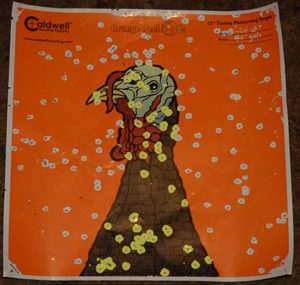
THIS TARGET SHOWS A LETHAL PATTERN of shot that would have struck the neck of a gobbler had it been a real turkey. Number 6 shot fired from a 12-gauge shotgun with a full choke from 40 yards was used for this picture. (Photo by John Jefferson)
Most spring turkey hunters nowadays hunt with shotguns. And most CALL the turkeys – instead of hunting near a feeder. Some take a friend along who likes to call gobblers. Believe me, there ARE guys like that!
The preferred shotgun gauge is 12-gauge. Twelves hurl more shot downrange! Twenties also work.
When turkey hunters began patterning their smoke poles, I took my favorite shotgun, a Winchester Model 12 in 16-gauge, to a patterning sponsored by Winchester Ammo. It was the same make and model my grandfather and his friend, Josh Munro, hunted with. “Úncle Josh” was my outdoors mentor. His gun was the first shotgun I ever fired.
Kevin Howard, a Winchester rep., looked at my patterning target and indicated the pattern was wide enough for a turkey to fly through without losing a feather! I changed to a full-choked shotgun, which is more popular among spring turkey hunters. A full choke holds the pattern tighter at most turkey ranges.
I contacted three friends who are expert turkey hunters. They’re all 12-gauge, full choke boys.
Marty Malin, a semi-retired outdoor writer, claims he burns up more ammo patterning than he does shooting at turkeys. It’s that important. Malin draws a turkey head and neck about life-size on paper or cardboard. He makes at least three such targets and shoots at one at 25 yards, 35, and 45 yards, all aimed at the base of its neck – NOT its body — to see where the shot hits. During the hunt, he paces off the distance from where he’ll sit to the target distance that had the most shot pellets in the head and neck. He places his decoy there. And hopes to call his bird within range. He shoots Bismuth #5 shot shells, but is interested in the new Federal TSS ammo.
Tom Granberry is a veteran turkey hunter who collects “strikers” for his “slate calls”. He’s got enough to rival the Aggie Bonfire. He doesn’t know how many. Granberry patterns his shotgun at 20 and 40 yards to see how high it shoots at 20, and how much it drops at 40. The way he talks about the Federal TSS loads, he ought to be on their staff. They’re heavier pellets in #7 shot than lead 7s since they are tungsten/steel. Last year, he dispatched a turkey at 59-yards – but advises against shooting at that range.
My last gobbler was about to disappear behind brush at the end of a hunt. I desperately shot it at just over 50-yards (according to my guide) with a Winchester Extended Range #6 shotshell. I wouldn’t try that again.
Horace Gore is a legendary hunter — one of the first turkey-calling hunters when Texas inaugurated spring turkey hunting in the early 70s. He patterns his 12-gauge at 35 and 40 yards, using #6 shot. Gore says call until you think the gobbler has heard you. Then stop and let him come in to your collapsible decoy.
Shoot for the head when you see his eye.
JJ



